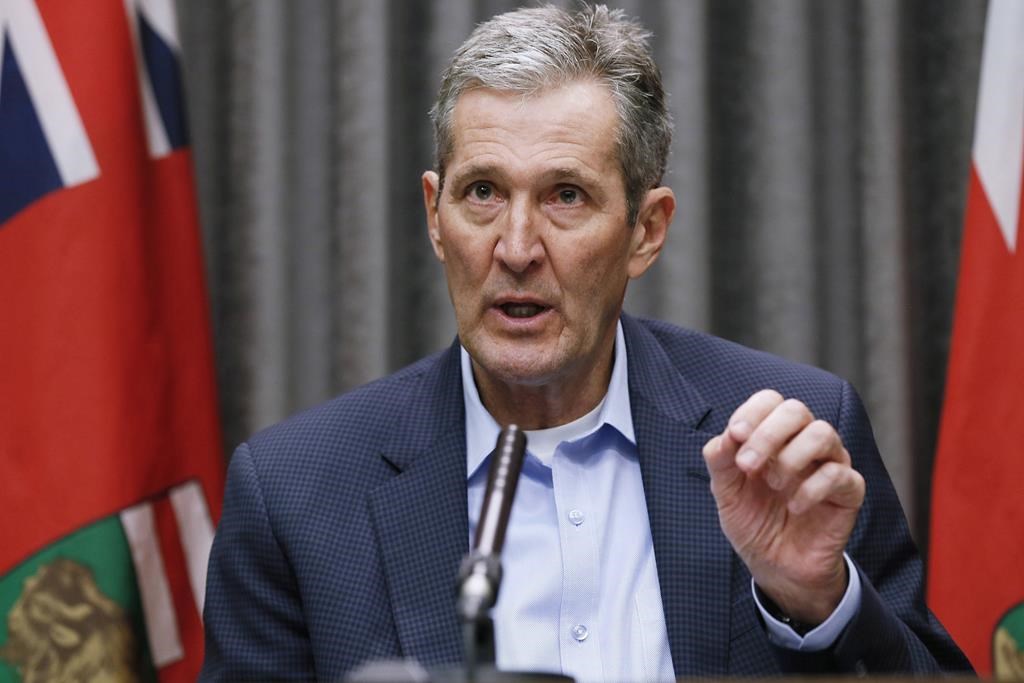Manitoba Premier Brian Pallister said Wednesday more than 78,000 Manitobans have qualified for the province’s COVID-19 “risk pay” program.

Pallister said the province will divide $120 million equally for eligible recipients for a payment of $1,530.
In all 78,442 essential workers will get the money.
But because the money is considered taxable income, the province says it will remit a 10 per cent withholding tax to the Canada Revenue Agency, meaning eligible recipients will ultimately have $1,377 direct deposited into their bank accounts.
The province says those payments will come this week, and eligible recipients will be notified by email when the deposit is made.
“We want to thank front-line workers and acknowledge the sacrifices they made during the COVID-19 pandemic and the increased risks they faced on the job to provide crucial services,” said Pallister, in a release.
“We also appreciate Manitobans’ patience as we reviewed every application we received in order to determine final payment amounts.”
The program provides a one-time payment to low-income, essential, front-line workers, who have taken risks to keep Manitobans safe during the period of March 20 to May 29 of the COVID-19 pandemic.

Funding for the program is split $90 million from the federal government and $30 million from the provincial government, but the province got to decide who would be eligible.
To qualify, people must have worked a minimum of 200 hours and their pre-tax employment income during the eligibility period must be less than $12,500.
Pallister said approved recipients include 37,060 public-facing essential roles in retail services and lodging, 27,085 in health care, 9,325 in social services and 3,440 in transportation.
“Many working Manitobans were exposed to on-the-job risks they’d never experienced prior to the pandemic and we can’t thank them enough for the roles they played in supporting all Manitobans through this difficult time,” said Pallister.
However, the phrase “public-facing” used by Pallister caught some off guard.
“That’s new, that hasn’t been in any of their messaging before,” said Jeff Traeger, president of UFCW Local 832.
“We’re taking a wait-and-see approach to try and see what that message meant, but it appears at first blush to look like they’re only going to pay this to people who had direct contact with the public.”
Traeger notes if that is the case, it could ostensibly mean people working behind the scenes in food production, warehouses or health care won’t get a share of the money despite having worked throughout the pandemic in higher-risk situations.
“This is not looking like a risk recognition payment, this is looking like more a wage top up,” said Michelle Gawronsky, president of the MGEU, adding if the program was truly about recognizing risk, a person wouldn’t be disqualified for having made too much money.
“Every Manitoban that provided services through the height of COVID in the MGEU’s eyes … should be recognized for the fact that they went to work, they provided services, they put themselves at risk, they put their families at risk.”
Both union leaders noted it won’t be known who or how many of their members actually benefited from the program until the money is in the bank.
The president of the Manitoba Association of Health Care Professionals, Bob Moroz, agreed the program didn’t appear to be geared towards ‘risk recognition,’ since many of his members likely make too much money to qualify.
“The person who earns less money by being at work less and therefore is at less mathematical risk receives the benefit and the others don’t, it makes no sense,” Moroz said.
“We brought it up over and over again, but that was ignored. We’re going to find ourselves in a position now where people who are full time are going to feel – and they’re justified in feeling – hard done by.”
The MAHCP represents some 6,500 members including pharmacists, dietitians, respiratory therapists, and lab technologists among many others.
Pallister first announced details of the joint federal-provincial Risk Recognition Program June 2.
Applications for the program closed at the end of June but until Wednesday, not a dime had been handed out.
The delay in payments — and seemingly little word from government on when they would come — had ruffled the feathers of unions representing the essential workers likely to qualify for the pay.
On Tuesday both the Manitoba Government and General Employees’ Union and UFCW Local 832 expressed concerns to Global News.
Pallister said Wednesday it took some extra time for due diligence and to make sure the money was split equally. The majority who ended up not qualifying came from the manufacturing industry, he said.
In a release the province said it based eligibility criteria on recommendations it received during “extensive consultations with business and union representatives.”
–With files from Brittany Greenslade

Questions about COVID-19? Here are some things you need to know:
Symptoms can include fever, cough and difficulty breathing — very similar to a cold or flu. Some people can develop a more severe illness. People most at risk of this include older adults and people with severe chronic medical conditions like heart, lung or kidney disease. If you develop symptoms, contact public health authorities.
To prevent the virus from spreading, experts recommend frequent handwashing and coughing into your sleeve. They also recommend minimizing contact with others, staying home as much as possible and maintaining a distance of two metres from other people if you go out. In situations where you can’t keep a safe distance from others, public health officials recommend the use of a non-medical face mask or covering to prevent spreading the respiratory droplets that can carry the virus. In some provinces and municipalities across the country, masks or face coverings are now mandatory in indoor public spaces.
For full COVID-19 coverage from Global News, click here.





Comments